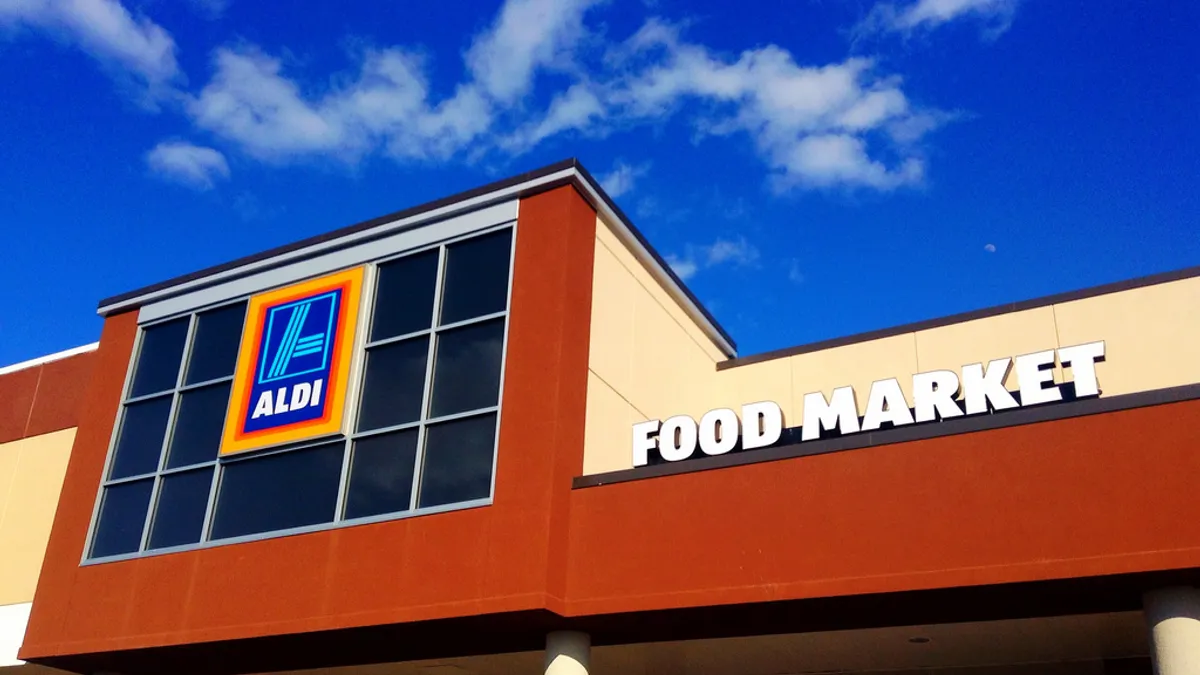Dive Brief:
- According to consulting firm Bain & Company, the expansion of German grocers Lidl and Aldi failed to measurably impact traditional grocers last year, but the discounters pose a growing threat thanks to improving consumer perception and advocacy. Up to 30% of U.S. consumers who shop at mass and traditional grocers also shop at Aldi or Lidl, according to the firm's latest report.
- In a survey of more than 17,000 consumers conducted by Bain and ROIRocket, Aldi, which is the midst of a $5 billion expansion and renovation drive, outperformed grocers in two key categories: “best everyday low prices” and “best value for the money.” The retailer had more than 3% market share of grocery spending in six of the eight markets studied in 2018 and saw its consumer advocacy score rise by 10% over last year. Lidl, meanwhile, is also seeing slow but steady gains against traditional grocers and had more than a 3% share in five of the seven markets in 2018.
- The report emphasizes that in order for U.S. grocers to stay competitive they should invest in convenience, advanced data and fresh assortment. Efficiency and value when it comes to online shopping is a key factor to winning on convenience while data should help traditional grocers stay on top of innovation and trends that keep consumers interested.
Dive Insight:
A study published last year by Catalina found that though Aldi's and Lidl's prices attract shoppers, they aren’t enough to keep them coming back.
But the discounters are working hard to become a regular destination for consumers, and the latest report from Bain & Company shows they're gaining traction. Both Aldi and Lidl aim to deliver the experience and convenience long associated with traditional grocers, but at a greater value. Aldi recently added in-demand and convenient products like fresh produce, marinated cilantro lime chicken breasts, bottled kombucha, single-serve guacamole and kale and quinoa burgers — products meant to draw new customers to stores while giving existing ones a reason to stop in more often.
Lidl, on the other hand, has made promotional as well as executive changes as it continues to focus on fresh categories and legacy strengths, like private label wine.
What should be particularly concerning for competitors is shoppers' increasing willingness to promote the hard discounters and recommend them to others. According to Bain's survey, Aldi's consumer advocacy increased to 55% last year from 46% in 2017.
How can traditional grocers fight back? According to the report, price is the most important factor for grocers in competition with discounters, but convenience and new technologies are gaining in significance. Twenty-six percent of respondents are shopping online and spending more with more frequency than customers who shop in-store. This is an excellent opportunity for traditional grocers to gain as only 1% of Aldi shoppers buy groceries online.
New technology goes hand-in-hand with convenience, the report notes. Grocers should be investing in data to better understand how their base wants to shop and how to use that information to keep them. Retailers should also continue to invest in "fresh" solutions — particularly in prepared foods and foodservice, where Aldi and Lidl have low to no presence.
Overall, the report is good news for traditional stores, but there’s no time to rest on those laurels. Discounters are intent on gaining ground and are nimble enough to make essential changes to reach and attract the right customers. Kent Knudson, a partner in Bain & Company's retail practice and a co-author of the report said, "As we've seen over the past year, the hard discounters know how to pivot their strategies in real-time as they get a feel for the U.S. market. They are still a force to be reckoned with."








